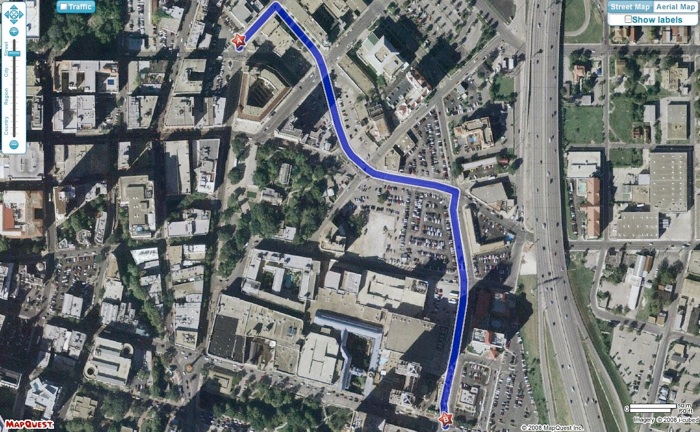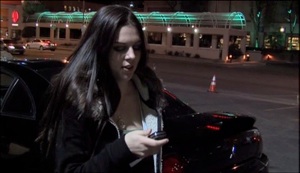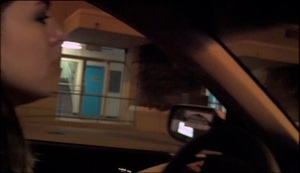Paranormal State Illustrated


Paranormal State Illustrated

Taking a close look at what you see and hear on a “Real Life. Drama.” TV series.
VEGAS: THE IMPOSSIBLE CALL
A phone call takes place between Ryan and Katrina. It couldn’t have happened as portrayed.
A brief phone call between Ryan and Katrina couldn’t have happened in real time as portrayed in the “Vegas” episode. Ryan was in Las Vegas, and Katrina was on the way to meet with “family” of Emily in San Antonio. The call was shown as lasting approximately 30 seconds.
By figuring out the starting and ending locations shown in this phone call sequence, I entered the addresses into MapQuest, which gave the approximate distance between the two locations as .53 mile, about 1/2 mile. So if Katrina actually covered this distance, she would have had to have driven faster than 60 MPH in order to cover the distance within 30 seconds, park, get out of the car, and say “Bye bye.” to Ryan.
I won’t disclose the address where Katrina is driving by in the scene below. If you know the address, you can use maps.live.com to search for the address, select the “Birds eye” view, and zoom in all the way. The default N–S view will give enough detail to make out the distinctive square-shaped cantilevered overhangs on the building to confirm that it is in fact the location marked “A” below. Another location/address check you can do is look up Herweck’s. Their store sign is visible in the background scene where the two young girls are wearing short skirts. Also in that scene, you can see a cantilevered overhang in Katrina’s rear-view-mirror of the building she drives by in the screenshot below. And, if you want to verify an aerial map of the San Antonio Marriott® Rivercenter on maps.live.com, type in the address, zoom in all the way using the “Bird’s eye” view, and use one of the rotating arrows to select the W–E view.
Note: the MapQuest map below is not the actual route Katrina drove. The image is used to illustrate the distance between two known points near the beginning and end of the phone call, and showing what is probably the shortest route to drive in the least amount of time.
THIS PHONE CALL SEGMENT IS MOST LIKELY AN ASSEMBLAGE OF SHOTS
During this phone call segment, notice that from the beginning to end of the call:
• Katrina has blemishes on her right cheek, as if she’s not wearing make-up. Single-stud earring in right ear.
• The car’s speedometer reads approximately 20 MPH- too slow in order to cover the 1/2 mile between locations within 30 seconds. Blemishes on Katrina’s cheek aren’t visible here.
• Katrina has blemishes again on her cheek as she holds the cell phone near her face.
• Another shot now shows the car’s speedometer at around 10 MPH. At this speed, there is no way possible to cover the 1/2 mile between locations within the 30 second phone call.
• Katrina is standing outside when she says “Bye bye” and we never heard any audible car signals such as a turn signal, an open door indicator, or headlights-on indicator. And, we never heard Katrina or the camera person(s) get out of the car or shut a door.
• After the call, Katrina is walking and her hair is now pulled/tied back. Possible different earring in her left ear.
If we heard an actual call in its entirety between Ryan (in Las Vegas) and Katrina (in San Antonio), there is no way she could have driven the approximate 1/2 mile distance from the start of the call, and ended up standing outside telling Ryan “Bye bye.” 30 seconds later. Katrina is traveling in different scenes at around 10- and 20 MPH which is far too slow to cover the distance in the given time. This is an example of creative editing.
First published: 22 Oct 2008
Last Updated: 16 Mar 2010
Written by: Ernie Marsh





Screenshot from mapquest.com
2008 © MapQuest Inc Map Data
© 2008 NAVTEQ or TeleAtlas
Screenshot from Paranormal State “Vegas”
The San Antonio Marriott® Rivercenter is visible in the background where the phone call ends.
Screenshot from Paranormal State “Vegas”
The building in the background is about where the phone call starts.
START
END



Note: This site is not owned by, or affiliated with Penn State, the Paranormal Research Society, A&E Television Networks, Go Go Luckey Productions, or Four Seasons Productions International, nor is it maintained or endorsed by them. Copyright © 2008-2012 Ernie Marsh.